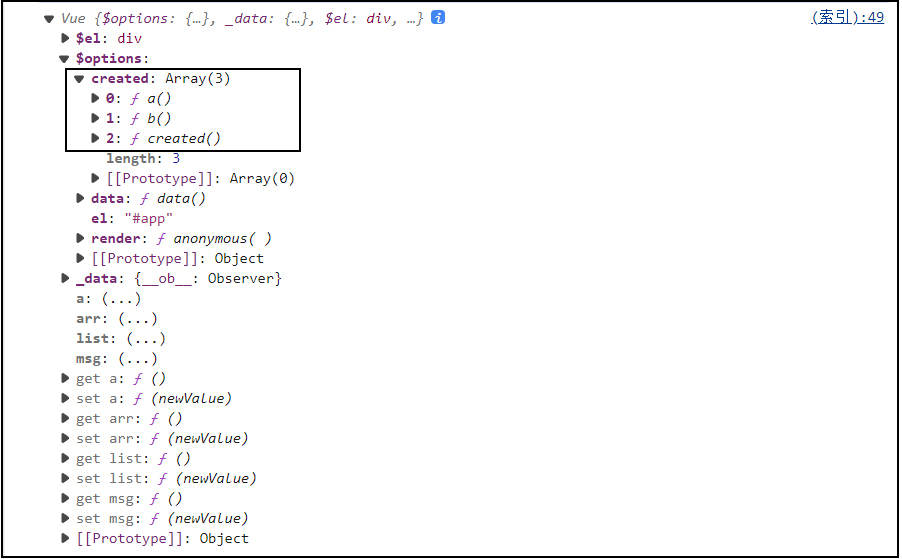好家伙,
1.使用场景
现在来,来想一下,作为一个使用Vue的开发者,假设现在我们要使用created(),我们会如何使用
1.1. .vue文件中使用
- <template>
- <div>
- <h1>{{ message }}</h1>
- </div>
- </template>
- <script>
- export default {
- created() {
- this.message = 'Hello, created() in single file component!';
- },
- data() {
- return {
- message: ''
- };
- }
- };
- </script>
1.2. Vue实例中使用
- <!DOCTYPE html>
- <html>
- <head>
- <title>Vue created() example</title>
- </head>
- <body>
- <div id="app">
- <h1>{{ message }}</h1>
- </div>
- <script src="https://cdn.jsdelivr.net/npm/vue@2.6.14"></script>
- <script>
- new Vue({
- el: '#app',
- data: {
- message: ''
- },
- created() {
- this.message = 'Hello, created() in Vue instance!';
- }
- });
- </script>
- </body>
- </html>
1.3. 混入
- Vue.Mixin({ //全局
- created:function a(){
- console.log('a----1')
- }
- })
那么如果我这样去定义
- <script>
- Vue.Mixin({ //全局
- created:function a(){
- console.log('a----1')
- }
- })
- Vue.Mixin({ //全局
- created:function b(){
- console.log('b----2')
- }
- })
- let vm = new Vue({
- el: '#app', //编译模板
- // data: {
- // },
- data() {
- // console.log(this)
- return {
- msg: 'hello',
- a: {
- b: 99
- },
- list: [1, 2, 3],
- arr: [{
- a: 1
- }]
- }
- },
- created(){
- console.log(555)
- }
- })
- </script>
是否会报错呢?
答案是不会
对于created()钩子函数,在每个Vue实例创建时,会依次执行全局混入函数中定义的created()方法和实例本身定义的created()方法。
当Vue实例被创建时,它会先执行全局混入函数的对应生命周期钩子函数,然后再执行实例本身的生命周期钩子函数。
因此,在你的代码中,全局混入函数中的created()会在实例的created()之前执行,且会按照它们在全局混入函数中的定义顺序执行。
这样的设计允许开发者在多个地方定义相同的生命周期钩子函数,以实现不同的功能扩展和逻辑处理。
同时,由于生命周期钩子函数的执行顺序已经确定,开发者可以根据需要合理安排代码逻辑
最后,也说明,created()定义的方法被合并处理了,所以我们要把这个"合并"实现
2.项目上下文
老样子,先看看项目更新了哪些东西
代码已开源https://github.com/Fattiger4399/analytic-vue.git

2.1.Vue入口文件index.js中

添加全局方法
2.2. global-api/index.js
- import { mergeOptions } from "../utils/index"
- export function initGlobApi(Vue) {
- //源码
- //Vue.options ={created:[a,b,c],watch:{a,b}}
- Vue.options ={}
- Vue.Mixin = function (mixin) { // {}
- //源码
- //{created:[a,b,c],watch:[a,b]}
- //对象的合并
- console.log(999)
- this.options = mergeOptions(this.options,mixin)
- console.log(Vue.options,"||this is vue.options")
- }
- }
此处涉及我们的核心方法mergeOptions
这方法要实现一个怎么样的效果?
- Vue.Mixin({ //全局
- created: function a() {
- console.log('a----1')
- }
- })
- Vue.Mixin({ //全局
- created: function b() {
- console.log('b----2')
- }
- })
- let vm = new Vue({
- el: '#app', //编译模板
- // data: {
- // },
- data() {
- // console.log(this)
- return {
- msg: 'hello',
- a: {
- b: 99
- },
- list: [1, 2, 3],
- arr: [{
- a: 1
- }]
- }
- },
- created() {
- console.log(555)
- }
- })
将上述所有与created()有关的方法
最后合并到一个对象当中去

3.核心方法
3.1.utils/index.js
来到我们全篇最核心也是最难的部分
- //对象合并 {created:[]}
- export const HOOKS =[
- "beforeCreated",
- "created",
- "beforeMount",
- "mounted",
- "beforeUpdate",
- "updated",
- "beforeDestory",
- "destroyed",
- ]
- // 策略模式
- let starts ={}
- starts.data =function(parentVal,childVal){
- return childVal
- } //合并data
- starts.computed =function(){} //合并computed
- starts.watch =function(){} //合并watch
- starts.methods =function(){} //合并methods
- //遍历生命周期
- HOOKS.forEach(hooks=>{
- starts[hooks] = mergeHook
- })
- function mergeHook(parentVal,childVal){
- if(childVal){
- if(parentVal){
- //把子元素合并进去
- return parentVal.concat(childVal)
- }else{
- return [childVal] //[a]
- }
- }else{
- return parentVal
- }
- }
- export function mergeOptions(parent, child) {
- console.log(parent,child,'||this is parent and child in mergeOptions()')
- const options ={}
- //判断父亲
- for(let key in parent){
- console.log(key,'||this is key')
- mergeField(key)
- }
- //判断儿子
- for(let key in child){
- console.log(key,'||this is key')
- mergeField(key)
- }
- function mergeField(key){
- //根据key 策略模式
- if(starts[key]){ //created {created:[a]}
- options[key] =starts[key](parent[key],child[key])
- }else{
- options[key] = child[key]
- }
- }
- return options
- }
前端设计模式之策略模式 - 掘金 (juejin.cn)
这玩意要看懂,必须先把这玩意学了,策略模式
一句话概括策略模式是一种行为型设计模式,它允许在运行时根据不同的情境选择并应用不同的算法或行为(不是条件判断)
挖个坑,后面会补一章策略模式
- //对象合并 {created:[]}
- export const HOOKS =[
- "beforeCreated",
- "created",
- "beforeMount",
- "mounted",
- "beforeUpdate",
- "updated",
- "beforeDestory",
- "destroyed",
- ]
- // 策略模式
- let starts ={}
- starts.data =function(parentVal,childVal){
- return childVal
- } //合并data
- starts.computed =function(){} //合并computed
- starts.watch =function(){} //合并watch
- starts.methods =function(){} //合并methods
- //遍历生命周期
- HOOKS.forEach(hooks=>{
- starts[hooks] = mergeHook
- })
- function mergeHook(parentVal,childVal){
- if(childVal){
- if(parentVal){
- //把子元素合并进去
- return parentVal.concat(childVal)
- }else{
- return [childVal] //[a]
- }
- }else{
- return parentVal
- }
- }
这里定义常量HOOKS包含了一组生命周期钩子的名字
随后创建starts对象,用于存储各个不同属性的不同合并策略
至于mergeHook,这就是个简单的合并方法,不用多解释了
-
再来看下半部分
- export function mergeOptions(parent, child) {
- console.log(parent,child,'||this is parent and child in mergeOptions()')
- const options ={}
- //判断父亲
- for(let key in parent){
- console.log(key,'||this is key')
- mergeField(key)
- }
- //判断儿子
- for(let key in child){
- console.log(key,'||this is key')
- mergeField(key)
- }
- function mergeField(key){
- //根据key 选择不同策略区处理
- if(starts[key]){ //created {created:[a]}
- options[key] =starts[key](parent[key],child[key])
- }else{
- options[key] = child[key]
- }
- }
- return options
- }
- mergeOptions将父项和子项合并成一个新的对象
这个你真的得亲自上手调试一下
3.2.init.js

这句就是将在option合并Vue.option中并返回给vm.$options
(option为new Vue时带的参数)
最后,看看效果
将方法都合并到了created中
